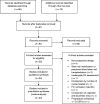Meta-analysis and indirect treatment comparison of lipegfilgrastim with pegfilgrastim and filgrastim for the reduction of chemotherapy-induced neutropenia-related events
- PMID: 28614980
- PMCID: PMC6094503
- DOI: 10.1177/1078155217714859
Meta-analysis and indirect treatment comparison of lipegfilgrastim with pegfilgrastim and filgrastim for the reduction of chemotherapy-induced neutropenia-related events
Abstract
Background Granulocyte colony-stimulating factors are effective at reducing the risk and duration of neutropenia. The current meta-analysis compared the neutropenia-related efficacy and safety of lipegfilgrastim to those of pegfilgrastim and filgrastim. Methods Embase was searched for trials examining the efficacy/safety of lipegfilgrastim, pegfilgrastim, or filgrastim. Outcomes included febrile neutropenia, severe neutropenia, duration of severe neutropenia, time to recovery of absolute neutrophil count, and incidence of bone pain. Direct comparisons were made using random-effects models. No trials directly compared lipegfilgrastim and filgrastim. Indirect comparisons were made between lipegfilgrastim and filgrastim with pegfilgrastim as the common comparator. Results This meta-analysis included a total of 5769 patients from 24 studies. Over all cycles, lipegfilgrastim showed a lower, nonsignificant risk of febrile neutropenia compared with pegfilgrastim. Lipegfilgrastim has a lower risk of febrile neutropenia versus filgrastim but was also not statistically significant. The risk ratio for severe neutropenia in cycle 1 was 0.80, a 20% reduction in favor of lipegfilgrastim. For cycles 2-4, the risk ratio was 0.53 (0.35, 0.79) for lipegfilgrastim versus pegfilgrastim. The risk of severe neutropenia in cycles 2-4 was also significantly lower for lipegfilgrastim (risk ratio 0.45, 0.27, 0.75, respectively). No significant differences were found for febrile neutropenia and severe neutropenia in cycle 1. However, in cycles 2-4, lipegfilgrastim was associated with significant and clinically meaningful reductions in risk of severe neutropenia versus either pegfilgrastim or filgrastim. Conclusions Compared with pegfilgrastim or filgrastim, lipegfilgrastim has a statistically significantly lower absolute neutrophil count recovery time; however, differences in duration of severe neutropenia and bone pain were nonsignificant.
Keywords: Neutropenia; filgrastim; lipegfilgrastim; meta-analysis; pegfilgrastim.
Figures
Similar articles
-
Efficacy and safety of lipegfilgrastim versus pegfilgrastim in elderly patients with aggressive B cell non-Hodgkin lymphoma (B-NHL): results of the randomized, open-label, non-inferiority AVOID neutropenia study.Support Care Cancer. 2021 May;29(5):2519-2527. doi: 10.1007/s00520-020-05711-7. Epub 2020 Sep 17. Support Care Cancer. 2021. PMID: 32944800 Free PMC article. Clinical Trial.
-
The impact of primary prophylaxis with granulocyte colony-stimulating factors on febrile neutropenia during chemotherapy: a systematic review and meta-analysis of randomized controlled trials.Support Care Cancer. 2015 Nov;23(11):3131-40. doi: 10.1007/s00520-015-2686-9. Epub 2015 Mar 29. Support Care Cancer. 2015. PMID: 25821144 Free PMC article.
-
Efficacy and safety of lipegfilgrastim versus pegfilgrastim: a randomized, multicenter, active-control phase 3 trial in patients with breast cancer receiving doxorubicin/docetaxel chemotherapy.BMC Cancer. 2013 Aug 14;13:386. doi: 10.1186/1471-2407-13-386. BMC Cancer. 2013. PMID: 23945072 Free PMC article. Clinical Trial.
-
Comparison of pegfilgrastim with filgrastim on febrile neutropenia, grade IV neutropenia and bone pain: a meta-analysis of randomized controlled trials.Curr Med Res Opin. 2007 Sep;23(9):2283-95. doi: 10.1185/030079907X219599. Curr Med Res Opin. 2007. PMID: 17697451
-
Refining the role of pegfilgrastim (a long-acting G-CSF) for prevention of chemotherapy-induced febrile neutropenia: consensus guidance recommendations.Support Care Cancer. 2017 Nov;25(11):3295-3304. doi: 10.1007/s00520-017-3842-1. Epub 2017 Aug 25. Support Care Cancer. 2017. PMID: 28842778 Free PMC article. Review.
Cited by
-
Long-acting granulocyte colony-stimulating factor pegfilgrastim (lipegfilgrastim) for stem cell mobilization in multiple myeloma patients undergoing autologous stem cell transplantation.Int J Hematol. 2021 Sep;114(3):363-372. doi: 10.1007/s12185-021-03177-9. Epub 2021 Jul 2. Int J Hematol. 2021. PMID: 34213732 Clinical Trial.
-
Effectiveness of single-dose 6 mg pegfilgrastim in mobilizing peripheral blood stem cells in allogeneic hematopoietic cell transplantation donors.Ann Hematol. 2023 Dec;102(12):3567-3573. doi: 10.1007/s00277-023-05469-y. Epub 2023 Sep 29. Ann Hematol. 2023. PMID: 37773294
-
Long-acting lipegfilgrastim and antimicrobials as vigorous primary prophylaxis in bendamustine-treated patients with indolent B cell non-Hodgkin lymphoma: a multicentric real-life experience.Support Care Cancer. 2025 Jul 14;33(8):691. doi: 10.1007/s00520-025-09743-9. Support Care Cancer. 2025. PMID: 40658252 Free PMC article.
-
Is PEGylated G-CSF superior to G-CSF in patients with breast cancer receiving chemotherapy? A systematic review and meta-analysis.Support Care Cancer. 2020 Nov;28(11):5085-5097. doi: 10.1007/s00520-020-05603-w. Epub 2020 Jul 3. Support Care Cancer. 2020. PMID: 32621264 Free PMC article.
-
Efficacy and safety of lipegfilgrastim versus pegfilgrastim in elderly patients with aggressive B cell non-Hodgkin lymphoma (B-NHL): results of the randomized, open-label, non-inferiority AVOID neutropenia study.Support Care Cancer. 2021 May;29(5):2519-2527. doi: 10.1007/s00520-020-05711-7. Epub 2020 Sep 17. Support Care Cancer. 2021. PMID: 32944800 Free PMC article. Clinical Trial.
References
-
- Crawford J, Dale DC, Lyman GH. Chemotherapy-induced neutropenia: risks, consequences, and new directions for its management. Cancer 2004; 100: 228–237. - PubMed
-
- Lyman GH, Dale DC, Crawford J. Incidence and predictors of low dose-intensity in adjuvant breast cancer chemotherapy: a nationwide study of community practices. J Clin Oncol 2003; 21: 4524–4531. - PubMed
-
- Lyman GH, Kuderer N, Greene J, et al. The economics of febrile neutropenia: implications for the use of colony-stimulating factors. Eur J Cancer 1998; 34: 1857–1864. - PubMed
-
- Webster J, Lyman GH. Use of G-CSF to sustain dose intensity in breast cancer patients receiving adjuvant chemotherapy: a pilot study. Cancer Control 1996; 3: 519–523. - PubMed
-
- Klastersky J, de Naurois J, Rolston K, et al. Management of febrile neutropaenia: ESMO Clinical Practice Guidelines. Ann Oncol 2016; 27: v111–v118. - PubMed
Publication types
MeSH terms
Substances
LinkOut - more resources
Full Text Sources
Other Literature Sources




